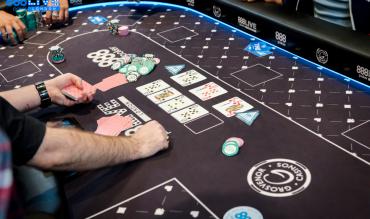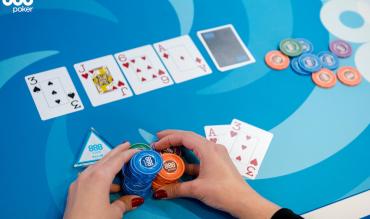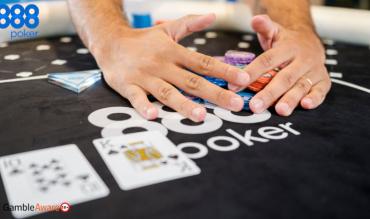Article updated on January 20, 2025
Understanding how the pot works is crucial to betting strategically and managing your stack effectively. It's the ultimate prize for each hand and the focal point of every poker game.
In this short guide to poker pots, we’ll discuss frequently asked questions like what starts a pot in poker.
We’ll clear up common misconceptions and give you essential strategy tips to consider when playing.
What is the Pot in Poker?
Before diving into more complex questions, let’s expand on the simple answer at the article's beginning.
The term "pot" in poker describes the total amount of chips or money wagered in a single poker hand. The pot grows as players place bets, calls, or raises during the different betting rounds.
At the end of the hand, the winning player takes the entire pot in the two following ways:
- Either by having the best hand at showdown
- Or by forcing all other players to fold before the showdown
What Starts a Pot in Poker?
A poker hand begins when the players place the initial bets in their designated positions. These initial bets are what start a pot in poker.
What starts a pot in poker depends on the poker variant:
- In Texas Hold'em and Omaha, for instance, the initial bets are the small blind and big blind. These bets are placed by the two players to the left of the button.
- There are no blinds in games like Seven Card Stud or Razz, and Antes start a pot. Every player must pay the Ante before being dealt any cards.
- [Note: Antes also exist in games with blinds, specifically in the mid and late stages of poker tournaments.]
How Do You Win the Pot in Poker?

There are two ways to win the pot in poker:
- Make a bet or raise, and all other players fold
- Reach showdown and have the best hand
Good poker players make use of both methods to maximize their poker earnings.
What Does it Mean to Buy the Pot in Poker?
Buy the pot is an old poker expression that most poker players are familiar with hearing. It means making a bet large enough that no player would be comfortable calling (presumably fold).
This poker phrase is common in situations where little interest has been shown in the pot so far.
Ironically, analysis shows that small bets are often more profitable in these scenarios.
What Is a Side Pot in Poker?
A side pot is a second pot occurring when one or more players are already all-in. All future chips will go into the side pot, and only players who contribute to that side pot can win it.
For example, if player A is all-in on the flop, only player B or C can win a side pot.
Player A can win the main pot, while player B or C wins the side pot.

Poker Pot Strategy Tips
Here are some fundamental tips about poker pots that should help you develop a solid poker strategy:
- Always be aware of your position at the poker table. When you have position over the other players in a hand, you can make informed decisions based on their actions. Therefore, you can maintain control of the pot size by betting aggressively when you have a strong hand and keeping the pot small when uncertain.
- Keep a close eye on the pot size at all times. Your bet sizes should have a direct relation to the pot size. You can extract maximum value by gradually building pots when you have strong hands. You'll also know how much to bet to make your bluffs as effective as possible with the help of pot odds.
What Are Pot Odds in Poker?
Pot odds in poker describe the price we get when facing a bet into a specific pot size. For example, if our opponent bets $50 into a $100 pot, we’d have to invest $50 into a total pot of $200 (including our call).
Our pot odds would be 3:1 (three-to-one ratio) or 25% (25% of the total pot).
What Does Pot Committed Mean in Poker?

A player is said to be pot committed when he has crossed the point of no return with his chip stack. In other words, if he had invested such a large portion of his stack, it would have been incorrect for him to fold when facing further action.
The exact point of becoming pot committed depends heavily on the situation.
What Does it Mean to Bet or Raise the Pot in Poker?
Bet or raise the pot means to bet or raise an amount equal to the current pot size. For example, if there is $100 in the pot, betting the pot would mean making a bet of $100.
Pot size raises are slightly more complex. We must first imagine we have called our opponent’s bet before calculating a pot-sized raise.
- For example, our opponent bets $100 into a $100 pot.
- We treat the pot size as $300 (the size it would be if we called).
- We need to raise the previous wager of $100 by $300 to $400 total.
- Our opponent must call $300 into a total pot of $900 (including his call).
We can confirm this is a pot-sized raise because our opponent now gets 2:1 (33%) pot odds on the call.
Poker Pot - Q&A
What is a poker pot called?
As beginners, some poker players might ask, “What is a poker pot called?”. It is called just that: pot. The pot refers to the chips or money at stake in a hand.
Who wins the pot in poker?
The player with the best hand at showdown or the last player remaining after everyone else folds takes the pot.
What happens to the pot if there’s a tie?
When two or more players tie at showdown, the pot is split equally between them.
Poker Pot - Final Thoughts
It’s worth remembering that the goal in poker is not necessarily to win the most pots. If we were to win a large number of small pots but lose all the big pots, we could end up losing overall.
The goal is to win the most chips (at least in a cash game). So, large pots are typically more crucial than small pots.
Why not check out the rules of poker?
Originally published on February 2, 2021


